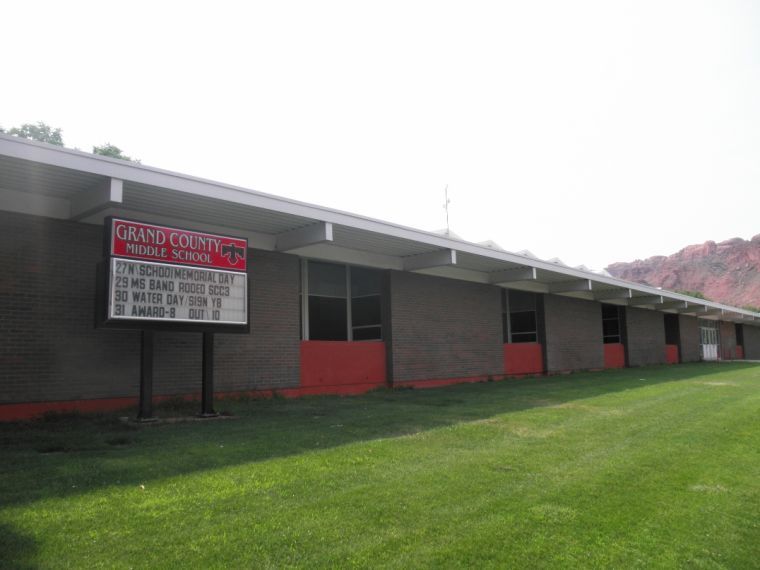The Grand County School Board unanimously approved the district’s budget for the next fiscal year. Included is a proposed property school tax increase that would set aside $200,000 annually into a newly created Capital Development Fund to be used “in an effort to meet the rising cost of improving and maintaining facilities.”
Should the school tax go into effect, a homeowner with a property appraised at $200,000 will pay an additional $7.92 a year; and a business owner with a $1 million assessed property will see their taxes increased by $72.
The proposed tax will now be subject to a public comment period, after which the board will vote on Aug. 21 to finalize the tax.
“We know we have capital issues in the district,” said Robert Farnsworth, the school district’s business administrator. “This seems like the most reputable method of dealing with them.”
Grand County School District has historically used bonds to build large-scale projects, such as the Grand County High School, Helen M. Knight Elementary School, and the High School Vocational Center.
“It’s always been bonds to build,” Farnsworth said.
The 20-year bond was approved by Grand County voters in 2008. The debt is now at $32,415,000 and the last payment will occur in 2028. In Dec. 2011 and March 2012, the district refinanced portions of the bond to reduce the bond interest by just under $1 million, Farnsworth said.
Farnsworth said that the best solution to avoid issuing more bonds is by raising money through taxes that can be used for future capital projects.
“We are trying to build this so when something major does come up, we are not scrambling,” he said.
There are several large projects that may need to be undertaken in the coming years.
The fifty-year-old middle school has a number of issues, including rusty pipes that turn the drinking water brown, and a noisy and antiquated ventilation system. The heating and cooling units at the high school, as well as the building’s roof, are also nearing the end of their lifespan.
“We are in the process of identifying all the capital project needs in the district that will become part of the five-year maintenance plan. Then we prioritize what we will use the money on over the next five years,” said Scott Crane, the district superintendent. “We wanted to put this in place for the future needs of the district.”
Critics contend that the school district should be focusing on getting out of debt rather than raising taxes to pay for new projects.
“(The school district’s plan) would cost more than just paying off the bonds, then starting to put money away,” said Tom Lacy, the accountant at Canyonlands Care Center.
He said that the school district should sell the former Red Rock Elementary property on Mill Creek Road and earmark that money for upgrades to the middle school.
Farnsworth agreed that if the district had started raising money through taxes in the ‘90s the current financial situation might be different. But it didn’t. Both he and Crane believe that it is more important to look towards what can be done in the future.
“We need to concentrate on what will be the needs in the future rather than dwelling on the past,” Crane said.
The Grand County School District has done several things to increase revenue. Over the past three years the district has frozen the tax rate. Historically in Grand County, when an area grows, the school tax rates for individual property owners go down as the school district collects money from more properties. Freezing the tax rate has meant that the school district has been able to increase their revenue without increasing the amount of money paid by individual taxpayers.
“Had we not frozen the tax rate, we would have lost that revenue,” Jim Webster, a Grand County School District board member, said of last year’s tax freeze.
Last year Grand County School District also annexed properties in Spanish Valley from the San Juan School District. The school district collected more money through school property taxes from these homes than it received in previous years from San Juan County for fees per student being educated in Grand County.
“We pitched this idea to (San Juan County) and they warmed up to it,” said Farnsworth. “They helped us a ton.”
Due in large part to the rising cost of retirement and insurance, the additional funds that the Grand County School District has received from freezing taxes and annexing properties has not been sufficient to allow the school board to put enough money away for capital projects.
The San Juan County School District, which has a higher school tax rate, has been able to replace schools with existing money; a feat that the Grand County School District would like to emulate in the future.
The San Juan School District collects $785 for every $100,000 a home is assessed. In Grand County, homeowners now pay $623.10 in school property tax and an additional $16.50 for the school bond per every $100,000 a home is assessed. Should the proposed school property tax be approved, Grand County homeowners would pay a total of $647.52 for school property tax and school bond, which is $138 less than they would pay in San Juan County for school property tax alone.
Lacy said that the capital fund already has $1.5 million in it. However, Farnsworth said this isn’t enough for necessary improvements at the middle school, let alone for all the other projects the district may have in the coming years.
Farnsworth pointed out that the amount that the school property tax is being raised is very small in comparison to the amount that they could legally raise it.
“This is what the school board is proposing,” he said. “It has to go through truth and taxation now.”
The truth in taxation process begins at 6 p.m., Aug. 14. The public is invited to submit their comments for the school board to take into consideration before they vote to finalize the tax on Aug. 21.
Farnsworth looks forward to the comments and believes that much of the criticism of the proposed tax raise comes from people only hearing part of the issue and not taking the time to get involved in the process.
“When I presented the budget there was one person in the audience,” he said. “People need to reach out and get involved. That’s just the bottom line.”





